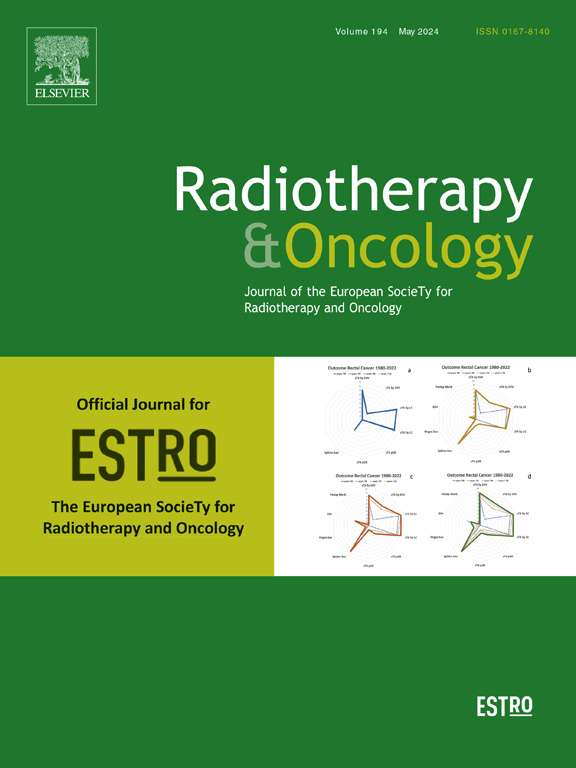深度学习剂量组学用于鼻咽癌放疗患者放射性皮炎的预处理预测。
IF 4.9
1区 医学
Q1 ONCOLOGY
引用次数: 0
摘要
目的:建立剂量组学和深度学习(DL)联合模型,基于放射剂量分布预测鼻咽癌(NPC)放疗后 ≥ 2级放射性皮炎(RD)的发生。材料和方法:回顾性研究来自两个医疗中心的290例鼻咽癌患者接受放疗。将患者分为三组:训练组(n = 167)、内部验证组(n = 72)和外部验证组(n = 51)。从辐射剂量分布中提取剂量组特征,并结合卷积神经网络衍生的DL特征进行分析,构建端到端模型,促进RD的预测。利用受试者工作特征(ROC)曲线下面积(AUC)评估和比较所建立模型的疗效。结果:最终筛选到的25个剂量学特征的XGBoost模型在内外验证集中的AUC分别为0.751和0.746。使用ResNet-34的DL模型在内部和外部验证集中的AUC分别为0.820和0.812。结合DL和剂量学特征,在内部验证集和外部验证集的AUC分别达到0.863和0.832。整合DL、剂量组特征和临床因素的Nomogram在训练、内部和外部验证集中的AUC分别为0.945、0.916和0.832。结论:结合DL、剂量组学和临床特征预测鼻咽癌RD是可行和有效的,从而加强鼻咽癌RT治疗患者的管理。本文章由计算机程序翻译,如有差异,请以英文原文为准。
Deep learning dosiomics for the pretreatment prediction of radiation dermatitis in nasopharyngeal carcinoma patients treated with radiotherapy
Purpose
To develop a combined dosiomics and deep learning (DL) model for predicting radiation dermatitis (RD) of grade ≥ 2 in patients with nasopharyngeal carcinoma (NPC) after radiation therapy (RT) based on radiation dose distribution.
Materials and methods
A retrospective study was performed with 290 NPC patients treated with RT from two medical centers. The patients were categorized into three groups: a training set (n = 167), an internal validation set (n = 72), and an external validation set (n = 51), respectively. Dosiomic features, in conjunction with DL features derived from convolutional neural networks, were extracted and analyzed from the radiation dose distribution to construct an end-to-end model and facilitate the prediction of RD. The efficacy of the developed models was assessed and compared using the area under curve (AUC) of the receiver operating characteristic (ROC) curves.
Results
The XGBoost model with finally screened 25 dosiomic features achieved the best AUC of 0.751 and 0.746 in the internal and external validation sets, respectively. DL model with ResNet-34 achieved the best AUC of 0.820 and 0.812 in the internal and external validation sets, respectively. Combining DL and dosiomic features improved the AUC to 0.863 and 0.832 in the internal and external validation sets, respectively. Nomogram integrating DL, dosiomic features, and clinical factors achieved an AUC of 0.945, 0.916, and 0.832 in the training, internal, and external validation sets, respectively.
Conclusion
The integration of DL, dosiomics and clinical features is feasible and effective for predicting RD, thereby enhancing the management of NPC patients treated with RT.
求助全文
通过发布文献求助,成功后即可免费获取论文全文。
去求助
来源期刊

Radiotherapy and Oncology
医学-核医学
CiteScore
10.30
自引率
10.50%
发文量
2445
审稿时长
45 days
期刊介绍:
Radiotherapy and Oncology publishes papers describing original research as well as review articles. It covers areas of interest relating to radiation oncology. This includes: clinical radiotherapy, combined modality treatment, translational studies, epidemiological outcomes, imaging, dosimetry, and radiation therapy planning, experimental work in radiobiology, chemobiology, hyperthermia and tumour biology, as well as data science in radiation oncology and physics aspects relevant to oncology.Papers on more general aspects of interest to the radiation oncologist including chemotherapy, surgery and immunology are also published.
 求助内容:
求助内容: 应助结果提醒方式:
应助结果提醒方式:


